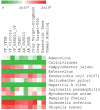Virulence factor activity relationships (VFARs): a bioinformatics perspective
- PMID: 28261716
- PMCID: PMC5897045
- DOI: 10.1039/c6em00689b
Virulence factor activity relationships (VFARs): a bioinformatics perspective
Abstract
Virulence factor activity relationships (VFARs) - a concept loosely based on quantitative structure-activity relationships (QSARs) for chemicals was proposed as a predictive tool for ranking risks due to microorganisms relevant to water safety. A rapid increase in sequencing capabilities and bioinformatics tools has significantly increased the potential for VFAR-based analyses. This review summarizes more than 20 bioinformatics databases and tools, developed over the last decade, along with their virulence and antimicrobial resistance prediction capabilities. With the number of bacterial whole genome sequences exceeding 241 000 and metagenomic analysis projects exceeding 13 000 and the ability to add additional genome sequences for few hundred dollars, it is evident that further development of VFARs is not limited by the availability of information at least at the genomic level. However, additional information related to co-occurrence, treatment response, modulation of virulence due to environmental and other factors, and economic impact must be gathered and incorporated in a manner that also addresses the associated uncertainties. Of the bioinformatics tools, a majority are either designed exclusively for virulence/resistance determination or equipped with a dedicated module. The remaining have the potential to be employed for evaluating virulence. This review focusing broadly on omics technologies and tools supports the notion that these tools are now sufficiently developed to allow the application of VFAR approaches combined with additional engineering and economic analyses to rank and prioritize organisms important to a given niche. Knowledge gaps do exist but can be filled with focused experimental and theoretical analyses that were unimaginable a decade ago. Further developments should consider the integration of the measurement of activity, risk, and uncertainty to improve the current capabilities.
Figures
Similar articles
-
Virulence factor activity relationships: challenges and development approaches.Water Environ Res. 2007 Mar;79(3):246-59. doi: 10.2175/106143007x156826. Water Environ Res. 2007. PMID: 17469656 Review.
-
Application of QSARs and VFARs to the rapid risk assessment process at US EPA.SAR QSAR Environ Res. 2008;19(5-6):579-87. doi: 10.1080/10629360802348944. SAR QSAR Environ Res. 2008. PMID: 18853303
-
Assessment of virulence-factor activity relationships (VFARs) for waterborne diseases.Water Sci Technol. 2004;50(1):309-14. Water Sci Technol. 2004. PMID: 15318527
-
Virulence factor-activity relationships: workshop summary.J Water Health. 2009;7 Suppl 1:S94-S100. doi: 10.2166/wh.2009.072. J Water Health. 2009. PMID: 19717934
-
Bioinformatics annotation of the hypothetical proteins found by omics techniques can help to disclose additional virulence factors.Curr Microbiol. 2009 Oct;59(4):451-6. doi: 10.1007/s00284-009-9459-y. Epub 2009 Jul 28. Curr Microbiol. 2009. PMID: 19636617 Review.
Cited by
-
Mining the Flavoproteome of Brucella ovis, the Brucellosis Causing Agent in Ovis aries.Microbiol Spectr. 2022 Apr 27;10(2):e0229421. doi: 10.1128/spectrum.02294-21. Epub 2022 Mar 22. Microbiol Spectr. 2022. PMID: 35315701 Free PMC article.
-
Genomic and transcriptomic survey of an endophytic fungus Calcarisporium arbuscula NRRL 3705 and potential overview of its secondary metabolites.BMC Genomics. 2020 Jun 24;21(1):424. doi: 10.1186/s12864-020-06813-6. BMC Genomics. 2020. PMID: 32580753 Free PMC article.
-
Unveiling the Potential Role of Nanozymes in Combating the COVID-19 Outbreak.Nanomaterials (Basel). 2021 May 18;11(5):1328. doi: 10.3390/nano11051328. Nanomaterials (Basel). 2021. PMID: 34069866 Free PMC article.
-
Antimicrobial Resistance Elements in Coastal Water of Llanquihue Lake, Chile.Antibiotics (Basel). 2024 Jul 22;13(7):679. doi: 10.3390/antibiotics13070679. Antibiotics (Basel). 2024. PMID: 39061361 Free PMC article.
-
Antibiotic resistance: Global health crisis and metagenomics.Biotechnol Rep (Amst). 2021 Feb 23;29:e00604. doi: 10.1016/j.btre.2021.e00604. eCollection 2021 Mar. Biotechnol Rep (Amst). 2021. PMID: 33732632 Free PMC article.
References
-
- [accessed December 2016];Classifying Drinking Water Contaminants for Regulatory Consideration. http://www.nap.edu/catalog/10080.html. - PubMed
-
- De Leon R. J. Water Health. 2009;7:94–100. - PubMed
-
- Cangelosi GA. J. Water Health. 2009;7:64–74. - PubMed
Publication types
MeSH terms
Substances
Grants and funding
LinkOut - more resources
Full Text Sources
Other Literature Sources



